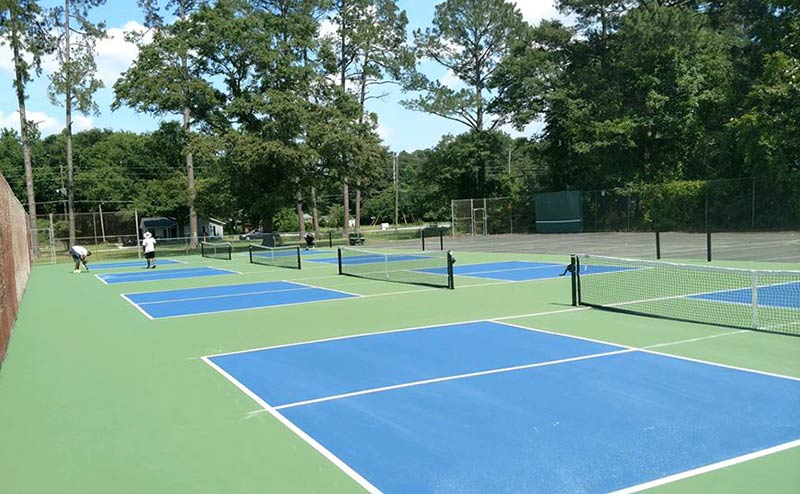Pickleball Court Construction-- Start Structure Your Perfect Court Today
Lasting Practices in Pickleball Court Building You Ought To Know
As the popularity of pickleball proceeds to increase, so also does the requirement for sustainable methods in court building and construction. This method not just addresses ecological issues but likewise boosts the long life and performance of the courts. From selecting environment-friendly products to implementing effective drain and energy-saving illumination solutions, there are various strategies to think about. The effect of these methods expands much beyond the court itself. Comprehending how each element contributes to an extra lasting future invites additionally expedition into the intricate balance in between entertainment growth and ecological stewardship.
Picking Eco-Friendly Materials
Selecting eco-friendly products is a crucial step in the construction of sustainable pickleball courts. The selection of lasting products not just lessens environmental influence yet also boosts the durability and efficiency of the court. Trick products include recycled rubber for the surface area, which offers superb resilience and shock absorption while drawing away waste from land fills.
Additionally, utilizing in your area sourced materials decreases transport exhausts and supports local economic climates. Pickleball court construction. Utilizing native hardwoods for fence and seating can give a lasting visual while making certain strength versus the elements.
Including absorptive materials for court foundations can further add to sustainability by allowing for natural water drainage and reducing drainage. These selections not just protect local ecological communities yet additionally promote much healthier play atmospheres.
Efficient Water Drainage Solutions
While the choice of environmentally friendly materials is vital, implementing effective drain services is equally vital for preserving lasting pickleball courts. Proper drainage not only safeguards the court surface area from water damages however additionally minimizes erosion and drainage, advertising environmental honesty.
Efficient water drainage systems can include absorptive paving, which permits water to penetrate the ground instead than pooling externally. This lowers the chance of standing water, which can cause mold and various other maintenance problems. In addition, incorporating purposefully placed drain channels and swales can route excess water away from the court area, making sure a completely dry playing surface and protecting against soil erosion.
Using indigenous greenery in the landscape design around the courts can additionally boost water drainage by absorbing excess water and lowering overflow. These plants need much less irrigation and advertise biodiversity, aligning with sustainable techniques.
Furthermore, it is crucial to consistently keep the water drainage system to guarantee its lasting effectiveness. This includes clearing particles and surveillance for clogs. By prioritizing reliable water drainage remedies, pickleball court builders can significantly add to the sustainability and long life of the facility, inevitably profiting both players and the atmosphere.
Energy-Efficient Lighting Options
As the demand for pickleball Visit Your URL remains to grow, integrating energy-efficient illumination alternatives right into court layout has actually ended up being significantly crucial for sustainability. Conventional lights systems frequently eat excessive energy, contributing to higher operational expenses and environmental impact. For that reason, embracing modern, energy-efficient technologies is necessary for both brand-new constructions and renovations.
LED (Light Emitting Diode) lights attracts attention as a premier selection because of its durability and power financial savings (Pickleball court construction). Compared look here to standard illumination, LEDs utilize roughly 75% less energy and can last approximately 25 times much longer, significantly minimizing upkeep expenses. The directional nature of LED illumination decreases light air pollution, making certain that illumination is concentrated on the court instead than surrounding areas.
Sustainable Surface Area Alternatives
Discovering sustainable surface area alternatives for pickleball courts has actually obtained traction amongst gamers and home builders alike. The emphasis on green materials not just straightens with the growing ecological recognition however also improves the performance and resilience of the courts.
This material offers outstanding shock absorption, lowering the threat of injuries for players while advertising sustainability. These floor tiles are simple to set up and change, and their flexibility allows for numerous court arrangements.
All-natural yard courts are additionally becoming a lasting option, promoting biodiversity and minimizing the warm island result. However, they call for normal upkeep and water, which might not line up with all sustainability goals.

Water Preservation Strategies

An additional efficient technique involves the setup of rainwater harvesting systems. These systems accumulate and save rainwater for usage Click Here in maintaining court surface areas and landscaping. This strategy not just preserves safe and clean water but also lowers reliance on community resources.
Furthermore, using drought-resistant landscaping around the courts is crucial. Indigenous plants call for much less water and are much better adjusted to local environment problems, therefore lowering general water usage. Furthermore, utilizing reliable watering systems, such as drip watering, makes certain that water is delivered directly to plant origins, decreasing dissipation and waste.
Verdict
Incorporating lasting practices in pickleball court building and construction substantially adds to environmental preservation and source effectiveness. By prioritizing these methods, the construction of pickleball courts can straighten with wider environmental objectives while advertising durability and functionality within areas.
As the popularity of pickleball continues to rise, so too does the need for sustainable practices in court construction.Choosing environment-friendly materials is a vital action in the building of lasting pickleball courts. By focusing on energy-efficient lights options, pickleball court constructors can add to an extra lasting future while fulfilling the demands of stakeholders and gamers alike.Integrating lasting surface area choices not only boosts the performance of pickleball courts however also paves the means for carrying out efficient water conservation strategies.Integrating sustainable techniques in pickleball court building dramatically adds to ecological preservation and resource performance.